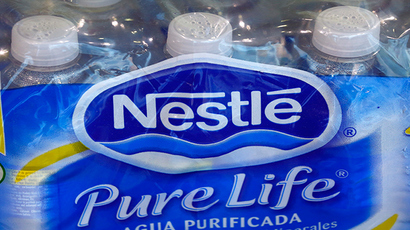California aquifers contaminated with billions of gallons of fracking wastewater

Industry illegally injected about 3 billion gallons of fracking wastewater into central California drinking-water and farm-irrigation aquifers, the state found after the US Environmental Protection Agency ordered a review of possible contamination.
According to documents obtained by the Center for Biological Diversity, the California State Water Resources Board found that at least nine of the 11 hydraulic fracturing, or fracking, wastewater injection sites that were shut down in July upon suspicion of contamination were in fact riddled with toxic fluids used to unleash energy reserves deep underground. The aquifers, protected by state law and the federal Safe Water Drinking Act, supply quality water in a state currently suffering unprecedented drought.
The documents also show that the Central Valley Water Board found high levels of toxic chemicals - including arsenic, thallium, and nitrates - in water-supply wells near the wastewater-disposal sites.
Arsenic is a carcinogen that weakens the immune system, and thallium is a common component in rat poison.
“Arsenic and thallium are extremely dangerous chemicals,” said Timothy Krantz, a professor of environmental studies at the University of Redlands, according to the Center for Biological Diversity.
“The fact that high
concentrations are showing up in multiple water wells close to
wastewater injection sites raises major concerns about the health
and safety of nearby residents.”
The Center for Biological Diversity obtained a letter from the state Water Board to the US Environmental Protection Agency (EPA) that said the Central Valley Regional Water Board discovered the health violations. Following the July suspension of the 11 injection sites, the EPA ordered a review of aquifers in the area to be completed within 60 days.
The state Water Board also said that 19 more injection wells may have also contaminated sensitive, protected aquifers, while dozens more wells have been the source of wastewater dumped into aquifers of unknown quality.
Despite these damning findings, the extent of wastewater pollution is still undetermined, as the Central Valley Water Board has thus far only tested eight water wells of the more than 100 in the area, according to the documents. Half of those tested came up positive for containing an excessive amount of toxic chemicals.
To unleash oil or natural gas, fracking requires blasting large volumes of highly pressurized water, sand, and other chemicals into layers of rock. The contents of fracking fluid include chemicals that the energy industry and many government officials will not name, yet they insist the chemicals do not endanger human health, contradicting findings by scientists and environmentalists. Toxic fracking wastewater is then either stored in deep underground wells, disposed of in open pits for evaporation, sprayed into waste fields, or used over again.
Fracking has been linked to groundwater contamination, an uptick in earthquakes, exacerbation of drought conditions and a host of health concerns for humans and the local environment.
A recent study by the US Drought Monitor noted that 58 percent of California is experiencing “exceptional drought,” which is the most serious category on the agency’s five-level scale. Meanwhile, a fracking job can require as much as 140,000 to 150,000 gallons of water per day, water that then cannot be consumed or used in farming operations.
The Center for Biological Diversity noted that the contamination of water sources could be much worse in another regard, as flowback water that comes from oil wells in the state can contain levels of benzene, toluene, and other toxic chemicals that are hundreds of times higher than legally allowed. Flowback fluid is then released back into wastewater storage wells. Chemicals like benzene can take years to eventually find their way to water sources.
“Clean water is one of California’s most crucial resources, and these documents make it clear that state regulators have utterly failed to protect our water from oil industry pollution,” said Hollin Kretzmann, an attorney for the Center for Biological Diversity.
“Much more testing is needed to gauge the full extent of water pollution and the threat to public health. But Governor [Jerry] Brown should move quickly to halt fracking to ward off a surge in oil industry wastewater that California simply isn’t prepared to dispose of safely.”














